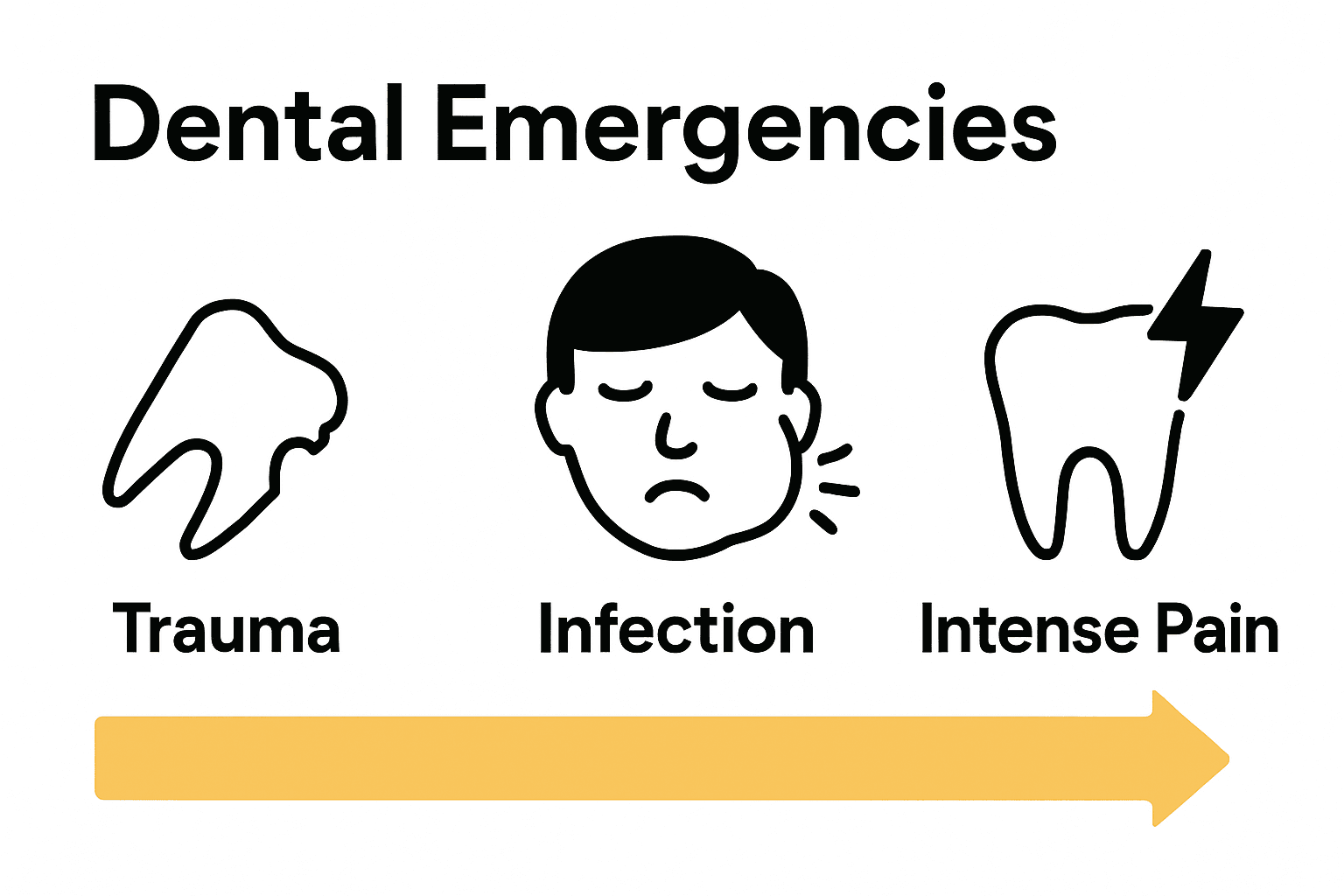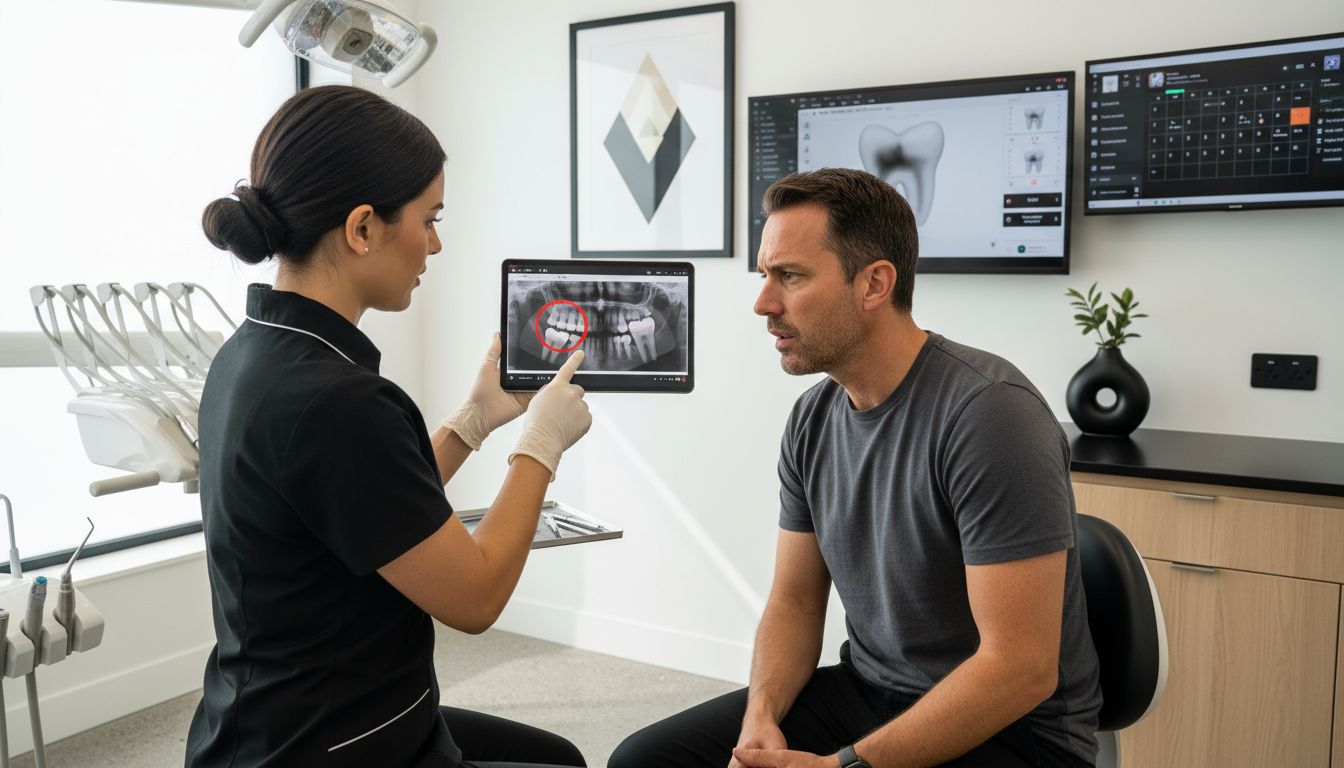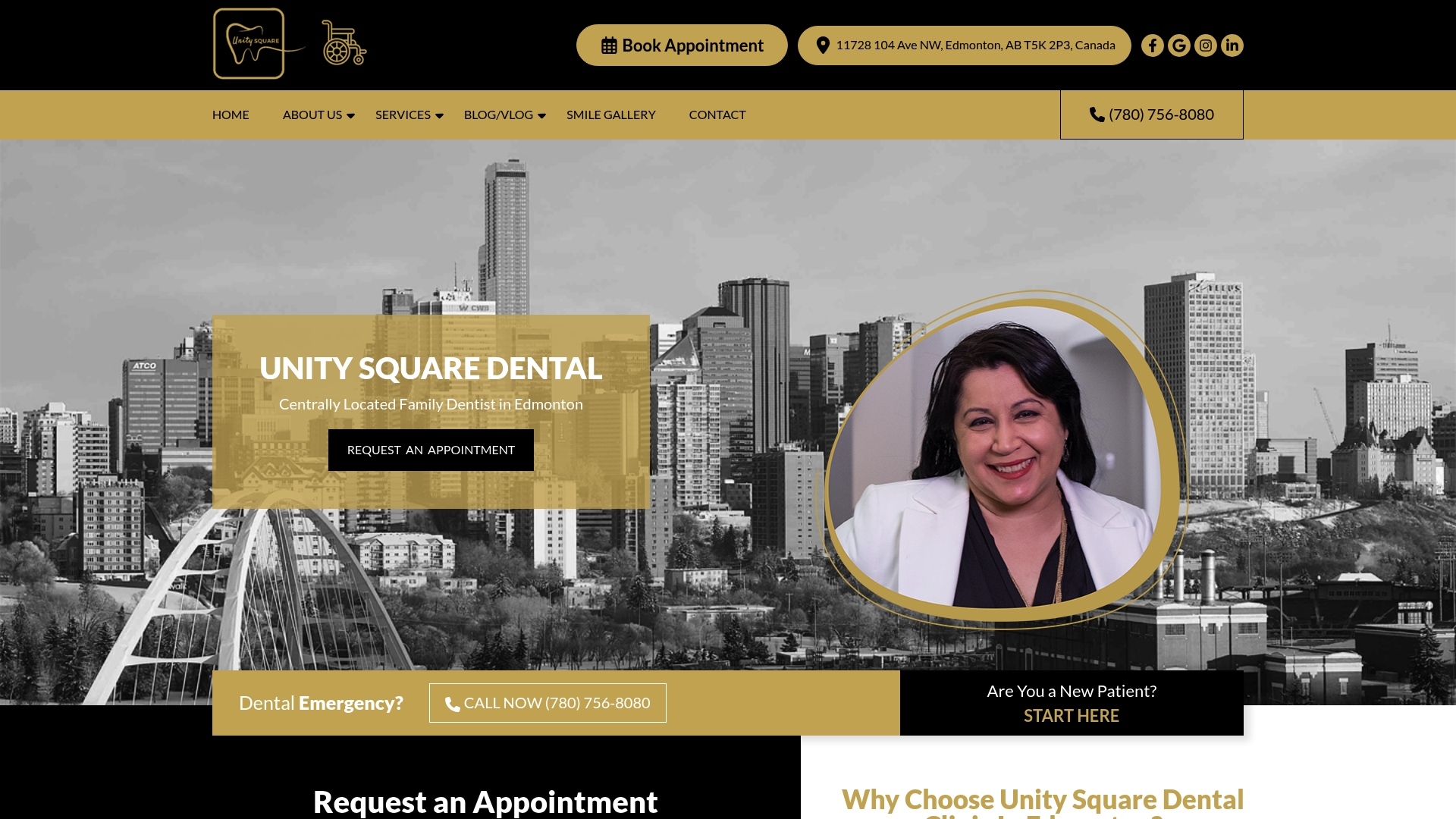
Every year, millions face sudden dental pain or trauma, yet only a fraction know which situations demand urgent care. Ignoring the warning signs of a true dental emergency can lead to severe infection or even permanent tooth loss. Knowing how to spot these critical moments protects not only your smile but your overall health, helping you act fast when it matters most.
Table of Contents
- Defining Dental Emergencies Accurately
- Types Of Dental Emergencies Explained
- How Emergency Dental Treatment Works
- When And Where To Seek Emergency Care
- Risks, Costs And Alternatives
- Preventing Dental Emergencies Effectively
Key Takeaways
| Point | Details |
|---|---|
| Understanding Dental Emergencies | Dental emergencies are urgent conditions that require immediate professional intervention to prevent significant health complications. |
| Types of Dental Emergencies | Key types include traumatic injuries, infectious conditions, intense pain, and uncontrolled bleeding, each necessitating prompt treatment. |
| Emergency Treatment Process | The emergency dental treatment process involves immediate symptom management, comprehensive assessment, and targeted intervention to ensure patient safety. |
| Prevention Strategies | Proactive dental care, including routine check-ups and proper hygiene practices, is essential for minimizing the risk of dental emergencies. |
Defining Dental Emergencies Accurately
A dental emergency is not just any tooth problem that feels uncomfortable. According to the PubMed research, the American Dental Association (ADA) defines dental emergencies as potentially life-threatening conditions requiring immediate treatment to stop bleeding, control infection, and alleviate severe pain.
The critical distinction is understanding what truly qualifies as an urgent dental situation. These are scenarios where delaying treatment could lead to significant health complications. Not all dental discomforts are emergencies, but those that involve active infection, uncontrolled bleeding, or intense, persistent pain demand rapid professional intervention.
Key indicators of a dental emergency include:
- Severe tooth or gum pain that prevents normal functioning
- Uncontrolled bleeding in the mouth
- Significant facial swelling indicating potential infection
- Trauma resulting in tooth displacement or complete avulsion
- Dental abscess with signs of systemic infection
While some dental issues can wait for a scheduled appointment, others require immediate action. Unity Square Dental’s guide on 10 most common dental emergencies provides comprehensive insights into recognizing when professional intervention becomes crucial. Understanding these distinctions could potentially save your teeth and prevent more complex health issues from developing.
Types Of Dental Emergencies Explained
Dental emergencies encompass a range of urgent conditions that require immediate professional attention. According to medical forums, these emergencies typically fall into several critical categories that demand swift intervention to prevent long-term complications.
Here’s a summary of the main types of dental emergencies and their key characteristics:
| Emergency Type | Common Examples | Urgency Level |
|---|---|---|
| Traumatic Dental Injuries | Knocked-out tooth Fractured tooth Soft tissue injury |
Immediate |
| Infectious Conditions | Severe abscess Oral cellulitis Spreading swelling |
Critical |
| Intense Pain/Functional Issues | Pericoronitis Acute TMJ disorder Severe toothache |
High |
| Bleeding Emergencies | Uncontrolled oral bleeding | Immediate |
| Tooth Displacement | Loose or displaced teeth | Immediate |
Traumatic Dental Injuries represent one of the most time-sensitive emergency types. These include:
- Completely knocked-out teeth (dental avulsion)
- Fractured or cracked teeth
- Severe tooth displacement
- Soft tissue injuries involving the mouth and gums
Infectious conditions constitute another significant category of dental emergencies. Dental infections can rapidly escalate from localized issues to systemic health threats. These typically manifest as:
- Severe tooth abscesses
- Cellulitis of the oral tissues
- Acute periodontal infections
- Spreading facial swelling
Some dental emergencies involve intense pain and functional disruption. Conditions like pericoronitis and acute temporomandibular joint disorders can significantly impair daily functioning. If you’re experiencing such symptoms, immediate dental consultation becomes crucial to prevent further complications and manage your pain effectively.
Recognizing these emergency types is only half the battle. Knowing when and how to seek professional help can make the difference between saving or losing a tooth, preventing serious infections, and maintaining overall oral health.
 Quick, informed action is your best defense against potentially serious dental complications.
Quick, informed action is your best defense against potentially serious dental complications.

How Emergency Dental Treatment Works
Emergency dental treatment is a structured process designed to provide rapid, targeted relief and prevent further complications. According to PubMed research, management of dental emergencies focuses on immediate symptom relief, followed by comprehensive evaluation to determine necessary subsequent treatments.
The typical emergency dental treatment follows a critical three-stage approach:
- Immediate Symptom Management
- Controlling pain and bleeding
- Stabilizing the affected area
- Preventing potential infection spread
- Comprehensive Assessment
- Detailed oral examination
- Diagnostic imaging (X-rays)
- Identifying underlying causes
- Determining extent of damage
- Targeted Intervention
- Performing necessary emergency procedures
- Prescribing appropriate medications
- Developing a follow-up treatment plan
Patients experiencing dental emergencies often require quick, specialized interventions. At-home pain relief techniques can provide temporary comfort, but professional assessment remains crucial. Dental professionals use advanced diagnostic tools and techniques to quickly diagnose and address urgent oral health issues, ensuring patients receive timely and effective care that minimizes long-term complications.
When And Where To Seek Emergency Care
Recognizing when to seek emergency dental care can be the difference between saving and losing a tooth. PubMed research emphasizes that immediate dental care is crucial for conditions involving severe pain, infection, or trauma, advising patients to contact their dentist or visit an emergency dental facility without delay to prevent worsening of the condition.
Urgent Scenarios Requiring Immediate Care:
- Uncontrolled bleeding from mouth or gums
- Severe, persistent tooth or jaw pain
- Significant facial swelling
- Traumatic dental injuries
- Signs of spreading oral infection
- Knocked-out or loose teeth
When faced with a dental emergency, patients have several immediate options. Local emergency dental clinics, hospital emergency rooms, and your primary dental office’s after-hours contact line are critical resources. Guide for determining when to see a dentist can help you navigate these critical decisions, ensuring you receive timely professional intervention.
Time is of the essence in dental emergencies. Delaying treatment can transform a manageable issue into a complex, potentially more painful and expensive problem. Always prioritize professional assessment, even if the symptoms seem minor. Quick action can preserve your oral health, prevent long-term complications, and potentially save a tooth from permanent damage.
Risks, Costs And Alternatives
Dental emergencies involve more than just immediate pain management. According to Gentle Dental, untreated dental emergencies can lead to significant health risks, including potential systemic complications and widespread infections that extend far beyond the initial oral problem.
Primary Health Risks of Delayed Treatment:
- Spread of localized infection to bloodstream
- Potential nerve damage
- Development of chronic pain conditions
- Risk of permanent tooth loss
- Increased complexity of future treatments
- Potential impact on overall immune system
From a financial perspective, emergency dental care can be surprisingly expensive. Hospital emergency departments typically charge approximately three times more than specialized dental clinics, making strategic care choices crucial. Exploring treatment alternatives can help patients manage both health risks and financial constraints effectively.
Navigating dental emergencies requires a balanced approach. While immediate professional intervention is critical, patients can mitigate risks by maintaining regular dental check-ups, understanding their insurance coverage, and having a clear emergency response plan. Proactive oral health management remains the most cost-effective strategy for preventing unexpected, potentially expensive dental complications.
Preventing Dental Emergencies Effectively
PubMed research highlights that proactive dental care is the most effective strategy for preventing emergency situations. Routine dental visits, meticulous oral hygiene, and strategic protective measures can significantly reduce the likelihood of unexpected dental complications.
Key Preventive Strategies:
- Brush teeth twice daily with fluoride toothpaste
- Floss at least once daily
- Use antiseptic mouthwash
- Replace toothbrush every 3-4 months
- Wear mouthguards during contact sports
- Avoid hard foods that could crack teeth
Certain lifestyle and health factors dramatically impact dental emergency risks. Understanding how medications affect dental health can help patients make informed choices that protect their oral wellness. Nutritional habits, stress management, and regular professional screenings play crucial roles in maintaining long-term dental integrity.
Protecting your teeth requires a holistic approach. Beyond daily hygiene, this means being aware of potential risk factors like teeth grinding, dietary choices, and physical activities that could compromise dental health. Regular dental check-ups allow professionals to detect and address potential issues before they escalate into painful, expensive emergencies.
When Every Moment Counts: Your Trusted Partner for Emergency Dental Care
Facing a dental emergency means dealing with sudden pain, swelling, or injury that demands immediate attention. The critical risks of delayed treatment highlighted in the article show how important it is to act swiftly to prevent lasting damage or infection. Whether you are experiencing severe tooth pain, uncontrolled bleeding, or traumatic injury, you deserve urgent, compassionate care from a trusted provider who understands the seriousness of your situation.
At Unity Square Dental, we specialize in rapid, expert emergency dental services delivered in a family-friendly, accessible environment right here in Edmonton. Our comprehensive approach includes advanced technology and personalized treatment plans to reduce your pain and protect your smile. Learn more about how we handle dental emergencies and discover effective at-home care tips in the meantime at How to Relieve Tooth Pain Naturally.

Do not wait until your dental issues worsen. Visit Unity Square Dental now for fast, reliable emergency care. Our flexible scheduling and welcoming staff are ready to help you regain comfort and confidence. Book your appointment today and take the first step toward immediate relief and lasting healing.
Frequently Asked Questions
What is considered a dental emergency?
A dental emergency is defined as a potentially life-threatening condition that requires immediate treatment to stop bleeding, control infection, or alleviate severe pain. Conditions such as uncontrolled bleeding, significant facial swelling, and severe tooth pain demand urgent professional attention.
How should I handle a knocked-out tooth?
If you experience a knocked-out tooth, handle it by the crown (the top part), avoid touching the root, and rinse it gently in water if dirty. Try to place it back into the socket if possible and keep it moist. If you cannot reinsert it, store the tooth in a container with milk or saliva and seek emergency dental care immediately.
What are the risks of delaying emergency dental treatment?
Delaying treatment for dental emergencies can lead to serious health risks including the spread of infection into the bloodstream, nerve damage, and permanent tooth loss, which can complicate future dental treatments and increase costs.
How can I prevent dental emergencies?
Preventing dental emergencies involves maintaining good oral hygiene, visiting your dentist regularly for check-ups, using mouthguards during contact sports, and avoiding hard foods that may crack teeth. Regular preventive care can significantly reduce the risk of unexpected dental issues.
Recommended
- Dental Care for Families in Edmonton: Your 2025 Guide – Unity Square Dental
- Choosing Dental Insurance in Edmonton: A 2025 Guide for All Needs – Unity Square Dental
- 7 Most Common Dental Treatments You Should Know – Unity Square Dental
- Dental Insurance in Alberta: Your 2025 Guide for Families and Residents – Unity Square Dental

